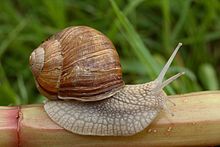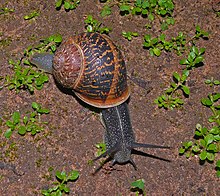Helicidae
| Helicidae | |
|---|---|

| |
| Helix pomatia | |
| Scientific classification | |
| Domain: | Eukaryota |
| Kingdom: | Animalia |
| Phylum: | Mollusca |
| Class: | Gastropoda |
| Subclass: | Heterobranchia |
| Order: | Stylommatophora |
| Superfamily: | Helicoidea |
| Family: | Helicidae Rafinesque, 1815 |
| Type genus | |
| Helix Linnaeus, 1758 | |
| Subfamilies | |
Helicidae is a large, diverse
Shell description
The shells are usually flattened or depressed conical. Globular shells are found in the genera Helix, Maltzanella, Lindholmia, Cornu, Cantareus, Eremina, and Idiomella. One species, Cylindrus obtusus, has a cylindrical shell. In some genera, especially in Cepaea, the shells are brightly colored and patterned.
Anatomy
Helicidae typically have a ribbed jaw, bursa copulatrix with a diverticulum, and one dart sac accompanied by a pair of (usually) branched, tubular mucous glands inserting at the base of the dart sac.[2]
Genetics
In this family, the number of
In the "Darwin Tree of Life"." project, four species (Cepaea nemoralis, Cepaea hortensis, Cornu aspersum, and Arianta arbustorum) are scheduled for whole genome sequencing and assembly ("Data portal".).

Distribution
The core of helicids is distributed in from the
Taxonomy



The family Helicidae contains 3 subfamilies (according to molecular phylogenetic analyses[9][10][11][12]):
Subfamily Helicinae Rafinesque, 1815
Genital system anatomy (does not apply on all species, as derived states are found in some of them): mucous glands divided into 2 or more branches, love dart with four blades (vanes) along its length, two penial papillae/verges.[citation needed]
Tribe Allognathini Westerlund, 1903[4]
Tribe Rafinesque, 1815[13]
- AristenaPsonis, Vardinoyannis & Poulakakis, 2022
- Amanica Nordsieck, 2017
- Caucasotachea Boettger, 1909
- Codringtonia Kobelt, 1898
- Helix Linnaeus, 1758 - type genus
- Isaurica Kobelt, 1901
- Levantina Kobelt, 1871
- Lindholmia Hesse, 1918
- Maltzanella Hesse, 1917
- Neocrassa Subai, 2005
Tribe Thebini Wenz, 1923[14][12]
A 2022 phylogenetic analysis proposed that all groups of the Maghreb radiation belonged to a single tribe, Thebini, without support for a separate Otalini tribe. The same study proposed a new tribe, Maculariini trib. nov. containing the genus Macularia due to the wide geographic disjunction between the western Alpine Macularia and the primarily Maghrebian Thebini tribe.[14]
- Cantareus Risso, 1826
- Cornu Born, 1778
- Eobania P. Hesse, 1913
- Eremina Pfeiffer, 1855
- Gyrostomella P. Hesse, 1911
- Loxana Pallary, 1899
- Massylaea Möllendorff, 1898
- Otala Schumacher, 1817
- Rossmaessleria P. Hesse, 1907
- Theba Risso, 1826
Tribe Maculariini Neiber, Korábek, Glaubrecht & Hausdorf, 2021
- Macularia Albers, 1850
Subfamily Murellinae Hesse, 1918[10]
Genital system anatomy (does not apply on all species, as derived states are found in some of them): mucous glands weakly branched or undivided, love dart with four blades along its length, one penial papilla.[15]
Distributed in Sardinia, Corsica, the Apennine Peninsula and Sicily.[15][16]
- Marmorana W. Hartmann, 1844
- Tacheocampylaea
- Tyrrheniberus
Subfamily Ariantinae Mörch, 1864[17]
Genital system anatomy (does not apply on all species, as derived states are found in some of them): mucous glands divided into 2 branches or undivided, love dart with two blades on the tip, one penial papilla.[citation needed]
- Arianta Turton, 1831
- Campylaea H. Beck, 1837
- Campylaeopsis A.J. Wagner, 1914
- Cattania Brusina, 1904
- Causa Schileyko, 1971
- Chilostoma Fitzinger, 1833
- Corneola Held, 1838
- Cylindrus Fitzinger, 1833
- Delphinatia P. Hesse, 1931
- Dinarica Kobelt, 1902
- Drobacia Brusina, 1904
- Faustina Kobelt, 1904
- Helicigona A. Férussac, 1821
- Isognomostoma Fitzinger, 1833
- Josephinella F. Haas, 1936
- Kollarix Groenenberg, Subai & E. Gittenberger, 2016
- Kosicia Brusina, 1904
- Liburnica Kobelt, 1904
- Pseudotrizona Groenenberg, Subai & E. Gittenberger, 2016
- Thiessea Kobelt, 1904
- Vidovicia Brusina, 1904
- †Pseudochloritis C. R. Boettger, 1909[18]
- †Mesodontopsis Pilsbry, 1895
- †Metacampylaea Pilsbry, 1895
- †Paradrobacia H. Nordsieck, 2014
- †Pseudoklikia H. Nordsieck, 2018
Incertae sedis
- †Megalotachea Pfeffer, 1930
References
- ^ M.P. Kerney & R.A.D. Cameron. 1979. A field guide to the land snails of Britain and northwestern Europe. Collins, London.
- ^ a b Nordsieck, Hartmut (1987). "Revision des Systems der Helicoidea (Gastropoda: Stylommatophora)". Archiv für Molluskenkunde. 118: 9–50.
- ISSN 1464-3766.
- ^ PMID 33965538.
- ^ Jickeli, Carl F. (1874). Fauna der Land- und Süsswasser-Mollusken Nord-Ost-Afrika's. Dresden: E. Blochmann & Sohn.
- ^ Neubert, Eike (1998). "Annotated checklist of the terrestrial and freshwater molluscs of the Arabian Peninsula with descriptions of new species". Fauna of Arabia. 17: 333–461.
- PMID 28563245.
- S2CID 84205240.
- PMID 25485783.
- ^ PMID 26256642.
- ISSN 0024-4082.
- ^ a b Holyoak, David T.; Holyoak, Geraldine A.; Gómez Moliner, Benjamín M.; Chueca, Luis J. (2020). "Phylogeny, species-limits and taxonomic revision of the Otalini (Helicidae) from north-west Africa". Journal of Conchology. 43: 551–611.
- ISSN 1424-2818.
- ^ .
- ^ a b Hesse, Paul (1908). Iconographie der Land- & Süsswasser-Mollusken mit vorzüglicher Berücksichtigung der Europäischen noch nicht abgebildeten Arten. Neu Folge. Vierzehnter Band. Wiesbaden: C. W. Kreidel.
- PMID 19995610.
- ISSN 1383-4517.
- ^ Höltke, Olaf; Rasser, Michael W (2015). "Pseudochloritis insignis–a peculiar large land-snail from the Miocene of SW Germany: taxonomic status and census of morphologically related forms". Journal of Conchology. 42 (1): 1.
